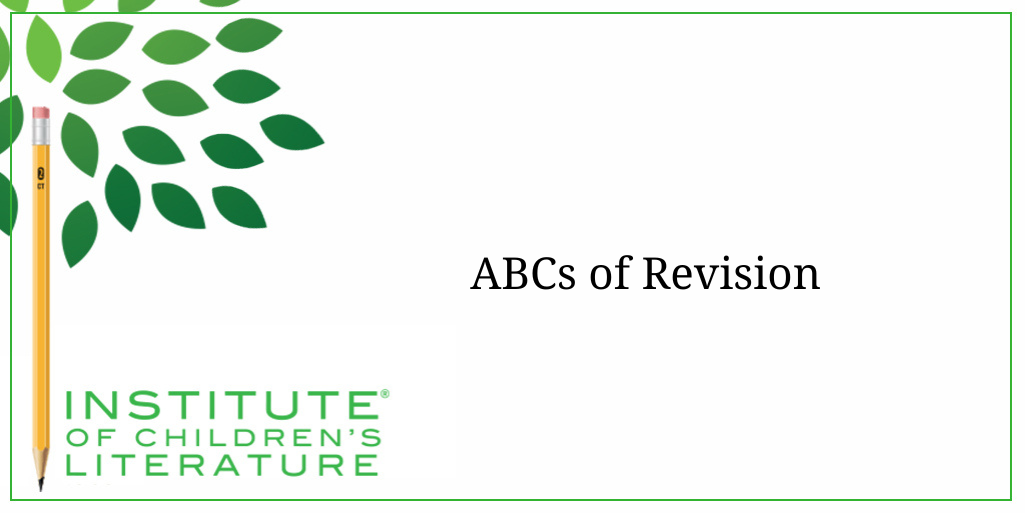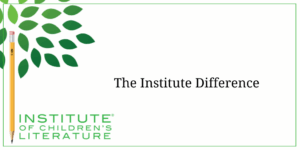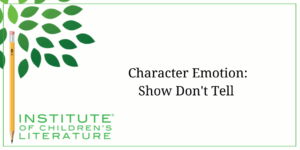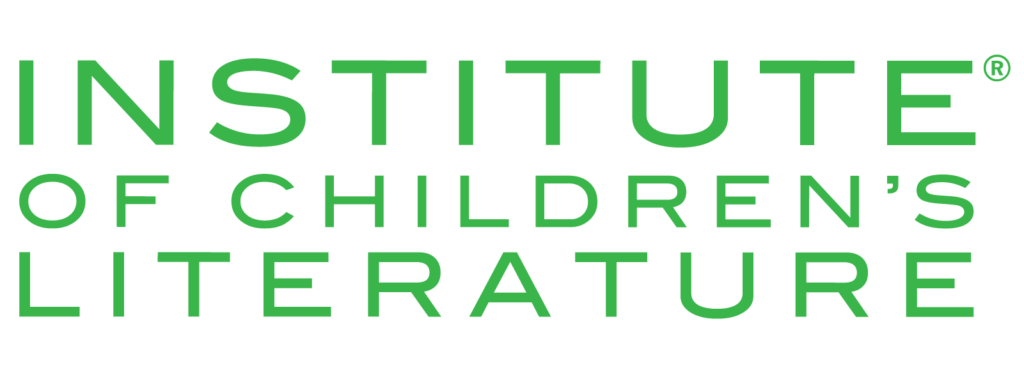
- Date: April 3, 2025
- Author: Jan Fields
- Category: Writing for Children Blog
- Tags: Revision, technique, tips
We teach our students how to write and get published!
View our Course Catalog >
ABCs of Revision
Revision is the act of improving a manuscript to make it closer to publication ready. It means not ignoring problems in the hopes that the editor or agent will fall in love with something about the book and either ignore the problems or help you fix them. These days agents and editors are not looking for projects that will require extra time and effort to make ready for publication. There will always be things the editor or agent can help with. But as much as possible, you need to present a manuscript without global issues. It's important to work methodically through revision so you can keep problems as small as possible. So, let's look at some important elements of revision. 
Age Affects It All
One of the most valuable things to do at the beginning of a revision is to think of your ideal reader. Who did you write this book for? To a certain extent, we write all of our books for ourselves, but we want them to go beyond ourselves and to suit a young reader especially well. Now, picking an ideal reader doesn't mean the book won't appeal to other readers, younger and older, but it does help in thinking through certain revision steps. This ideal reader effects so many decisions in the revision process.
For one, the idea real will be of a specific age. Thus, they will likely have an expected reading level. Writing far below that level will open up the book to younger reader but risks alienating the ideal reader who may be looking for something more complex or more challenging. The idea reader can also be expected to bring certain prior knowledge to the book.
For instance, a six-year-old will know little to nothing about the Civil War, but a teenager will know the broad outlines of what the war was about and the times in which it happened. If you jump into something without thinking about what your ideal reader can be expected to know, you will risk either talking over the head or the reader or insulting them by assuming they don't have basic knowledge shared by that age group. Once you realize where your reader is on these elements, you can revise with those things in mind.
 Additionally, reader age can affect core issues young people face. If your ideal reader is ten, that person is probably not thinking about college or the reality of work or the challenges of independent living, but an ideal reader of sixteen may be beginning to consider all of those things. An ideal reader of twelve to fourteen may be dealing with the effects of adolescent body and hormone changes that a reader of eight simply won't understand, and a reader of sixteen already has a handle on.
Additionally, reader age can affect core issues young people face. If your ideal reader is ten, that person is probably not thinking about college or the reality of work or the challenges of independent living, but an ideal reader of sixteen may be beginning to consider all of those things. An ideal reader of twelve to fourteen may be dealing with the effects of adolescent body and hormone changes that a reader of eight simply won't understand, and a reader of sixteen already has a handle on.
So, as you consider what issues and what themes your book explores, you will ask yourself if these are congruent with your idea reader's situation. Ignoring these elements sometimes results in rejections that laud the writing but saying it seems a better fit for a different age group —most of the time this is because these core issues don't work for the reader reflected in the language and voice choices. In revision, you make sure all of it lines up to work for the core reader.
Beware Error Blindness
When we first finish our rough draft, our brains are still in writing mode. We know what we meant to say. We know how it sounds in our head. That can lead to error blindness. We tend to read over typos and all sorts of errors in grammar, punctuation, verb tenses, wrong word use, and more. We also tend to struggle to catch errors in meter and rhyme in picture books. We read what we meant to write, and sometimes that is not exactly what we've written.
The number one best thing to do for error blindness is to give a manuscript time away from your eyes. This time helps your brain to switch from writer mode to reader mode. It is much easier to catch errors when in reader mode. So, when possible, many writers give a manuscript some rest time before jumping into revision. Unfortunately, sometimes we can't allow enough rest time because of deadlines, schedules, or simply impatience. We may need other ways to help us deal with error blindness. 
There are all sorts of tricks to help deal with error blindness. One is to make the manuscript look different. You may change the font, the margins, the color of the print, any of these things can make the book feel new to our brains and keep us from reading it as the writer. You may try using different color highlighters to mark the things you most need to double-check like all the verbs, or all the character names (multiple spellings of character names is one of my big blunder problems). Even randomly highlighting can help the manuscript look new and different. For very short manuscripts, an option is reading the manuscript backwards to help make errors jump out at you.
Another frequent help is reading the manuscript aloud. If it is a rhyming manuscript, you may need to have someone else read it aloud to you. Short manuscripts really should be read aloud before you consider submitting them. You'll nearly always catch something if you read the piece aloud. For longer pieces, I sometimes have my computer read the manuscript to me with a text to speech app. The voices of these have gotten better, thus making them more helpful in catching awkward prose, typos, and other issues.
Condescension Prevents Connection
No one enjoys being talked down to. Think of the times in your life when someone was clearly talking down to you, assuming you lacked the capacity to be treated as an equal. How did you feel about that person? How do you feel when someone behaves as if they think you're stupid? Most of us aren't particularly happy about that. Neither are young readers. One of the most important ways to connect with readers is through respect.
How does disrespect manifest in manuscripts? One is through an overly chippy or cajoling tone. Think of it as the tone we use when talking to infants or pets. On a continuum between the tone you use for your boss and the tone you use for your pet, you want to err on the side of respect, because the overly cheery, cajoling tone we use for pets doesn't endear you to young readers.
 Young people don't see themselves as being like puppies, so whenever the tone drifts toward overly chipper or cajoling, readers resist connecting with it. A chipper or cajoling tone happens most often when newer writers try to write nonfiction for young readers. It grows out of the erroneous belief that kids don't like nonfiction and need to be jollied into reading it. Kids love nonfiction. And they prefer to get to the exciting bits without being cajoled or talked down to.
Young people don't see themselves as being like puppies, so whenever the tone drifts toward overly chipper or cajoling, readers resist connecting with it. A chipper or cajoling tone happens most often when newer writers try to write nonfiction for young readers. It grows out of the erroneous belief that kids don't like nonfiction and need to be jollied into reading it. Kids love nonfiction. And they prefer to get to the exciting bits without being cajoled or talked down to.
As bad as the chipper tone is, the preachy tone is even worse. A startling number of new writers go into the business of writing for children to fix them. Now, at one time, the overly preachy morality tale for children was quite popular. Parents actually snapped up tales where naughty children ended up in dreadful situations and deserved them. But that's not an approach that works with children or parents, for the most part, anymore.
Young people don't enjoy being lectured any more than adults do. Imagine you picked up a book to help you organize your daily tasks, and immediately realized the author thought your primary problem was laziness. How badly would that hurt your willingness to believe anything that author said could be helpful? You wouldn't like it as an adult because it is disrespectful. Kids dislike it for the same reason. If you want to help children deal with problems they may be facing, do it in a respectful way. Frankly, if you have no respect for young people, you will find more success if you don't write for them.
When reading through your manuscript, ask yourself, if you were reading a book targeting someone exactly your age that used this tone, how would you feel? Really think about it. This is important for revision. Young people don't enjoy being talked down to or lectured, and if you slip into those tones, whatever else you're trying to do will fail, because you failed at the most important step: respect.
Is That All?
There is a lot to revision, but if you begin with these ABCs, you'll have corrected some serious issues that many writers overlook. And that will put you in a strong place when you're competing with all the other writers shooting for that spot at a publishing house or in a magazine. And you are competing. As much as I want to see all writers rise together, I am equally aware that at any specific publishing house, there are limited spaces, and my work is competing with other strong, competent writers. Any way you can nose out the competition puts you in a very good place indeed. So, mind your ABCs and good luck!
Related Articles for Revision
With over 100 books in publication, Jan Fields writes both chapter books for children and mystery novels for adults. She’s also known for a variety of experiences teaching writing, from one session SCBWI events to lengthier Highlights Foundation workshops to these blog posts for the Institute of Children’s Literature. As a former ICL instructor, Jan enjoys equipping writers for success in whatever way she can.




